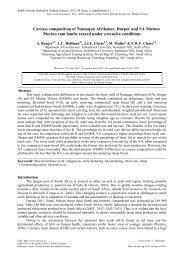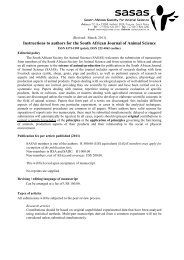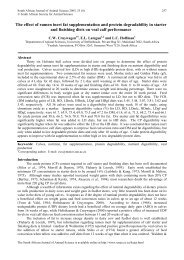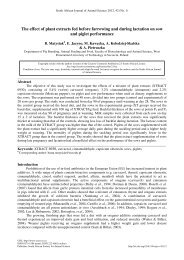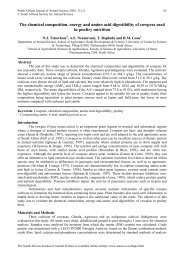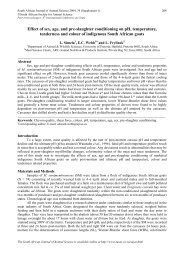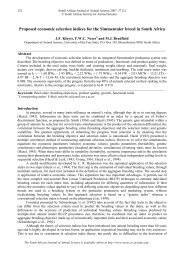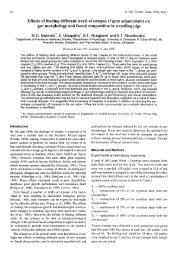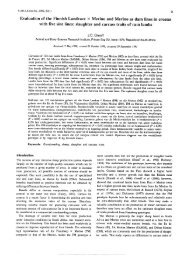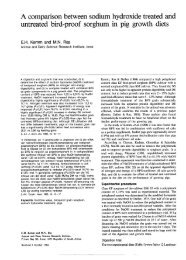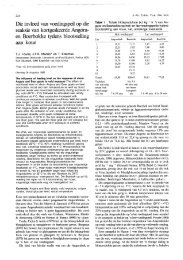Sensory and objective mutton quality characteristics of SA - African ...
Sensory and objective mutton quality characteristics of SA - African ...
Sensory and objective mutton quality characteristics of SA - African ...
You also want an ePaper? Increase the reach of your titles
YUMPU automatically turns print PDFs into web optimized ePapers that Google loves.
South <strong>African</strong> Journal <strong>of</strong> Animal Science 2003, 33 (1)<br />
© South <strong>African</strong> Society for Animal Science<br />
62<br />
ratio <strong>of</strong> lipids from bovine or lamb meat to be between 0.11 <strong>and</strong> 0.15 (Geay et al.,2001). The PUFA:SFA<br />
ratio <strong>of</strong> the four groups in this investigation differed (P ≤ 0.05), but were all markedly below the<br />
recommended value <strong>of</strong> 0.45. The P group had a higher PUFA:SFA ratio <strong>of</strong> 0.143, compared to the N<br />
production group that had a PUFA:SFA ratio <strong>of</strong> 0.115.<br />
Conclusions<br />
The <strong>objective</strong> <strong>of</strong> this investigation was to determine if meat <strong>quality</strong> differed between two lines <strong>of</strong><br />
South <strong>African</strong> Merino sheep that were divergently selected for <strong>and</strong> against multiple-rearing ability.<br />
Differences detected in meat <strong>quality</strong> between the two lines were <strong>of</strong> a slight magnitude, although more<br />
important differences were found in the WBS values <strong>and</strong> mineral <strong>and</strong> fatty acid composition <strong>of</strong> the meat.<br />
However, the latter did not affect the sensory <strong>quality</strong> <strong>of</strong> the meat. This investigation provides important<br />
scientific insight into the effect <strong>of</strong> reproduction rate on general <strong>mutton</strong> <strong>quality</strong>. Results indicated that the<br />
selection <strong>of</strong> sheep for an increased multiple-rearing ability did not result in negative correlated responses on<br />
general <strong>mutton</strong> <strong>quality</strong> <strong>and</strong> therefore appears to be feasible. The only exception was with regard to<br />
tenderness, where the <strong>mutton</strong> derived from the positive line animals was generally tougher, according to<br />
WBS measurements, than the negative line contemporaries. This point needs further elucidation, as this is a<br />
<strong>quality</strong> attribute that plays an important role in a consumer’s decision on whether to purchase or not to<br />
purchase a specific meat type.<br />
Analytical results <strong>of</strong> the fatty acid <strong>and</strong> mineral content <strong>of</strong> <strong>mutton</strong> derived from sheep raised under<br />
typical South <strong>African</strong> conditions are reported on a fresh meat basis <strong>and</strong> will serve as valuable information to<br />
use in national food composition tables.<br />
Acknowledgement<br />
The financial contributions <strong>of</strong> the South <strong>African</strong> wool industry to the maintenance <strong>of</strong> the breeding flock, the<br />
Technology <strong>and</strong> Human Resources for Industry Program (THRIP) <strong>and</strong> the National Resources Foundation<br />
(NRF) <strong>of</strong> South Africa are gratefully acknowledged.<br />
References<br />
Alex<strong>and</strong>er, G., 1988. What makes a good mother? Proc. Austr. Soc. Anim. Prod. 17, 25-41.<br />
AM<strong>SA</strong>, 1978. Guidelines for cookery <strong>and</strong> sensory evaluation <strong>of</strong> meat. American Meat Science Association,<br />
National Livestock <strong>and</strong> Meat board, Chicago, IL.<br />
AOAC, 1997. Official Methods <strong>of</strong> Analysis. (16 th ed.). Association <strong>of</strong> Official Analytical Chemists, Inc.,<br />
Arlington, Virginia, U<strong>SA</strong>.<br />
Banskalievaa, V., Sahlu, T. & Goetsch, A. L., 2000. Fatty acid composition <strong>of</strong> goat muscles <strong>and</strong> fat<br />
deposits: a review. Small Rum. Res. 37, 255-268.<br />
Cloete, S.W.P., 1999. Selection for weight <strong>of</strong> lamb weaned per breeding ewe. Elsenburg J. 1/2, 13-16.<br />
Cloete, S.W.P. & Dur<strong>and</strong>, A., 1994. A preliminary note on Merino sheep subjected to divergent selection on<br />
maternal values for lambs weaned per ewe joined. S. Afr. J. Anim. Sci. 24, 27-29.<br />
Cloete, S.W.P. & Olivier, J.J., 1998. Direct correlated responses to divergent selection for multiple-rearing<br />
ability on South <strong>African</strong> Merinos. In: Proc. 36 th National Congr. S. Afr. Soc. Anim. Sci., University <strong>of</strong><br />
Stellenbosch <strong>and</strong> Elsenburg, 5-8 April 1998, pp. 65-68.<br />
Cloete, S.W.P. & Scholtz, A.J., 1998. Lamb survival in relation to lambing <strong>and</strong> neonatal behaviour in<br />
medium wool Merino lines divergently selected for multiple-rearing ability. Aust. J. Exp. Agric. 38,<br />
801-811.<br />
Crouse, J.D., Ferrel, C.L. & Cross, H.R., 1983. The effect <strong>of</strong> dietary ingredients, sex, <strong>and</strong> slaughter weight<br />
on cooked meat flavour pr<strong>of</strong>iles <strong>of</strong> market lamb. J. Anim. Sci. 57, 1146-1153.<br />
Ellis, M., Webster, G.M., Merrell, B.G. & Brown, I., 1997. The influence <strong>of</strong> terminal sire breed on carcass<br />
composition <strong>and</strong> eating <strong>quality</strong> <strong>of</strong> crossbred lambs. Anim. Sci. 64, 77-86.<br />
Fisher, A.V., Enser, M., Richardson, R.I., Wood, J.D., Nute, G.R., Kurt, E., Sinclair, L.A. & Wilkonson,<br />
R.G., 1999. Fatty acid composition <strong>and</strong> eating <strong>quality</strong> <strong>of</strong> lamb types derived from four diverse breed x<br />
production systems. Meat Sci. 55, 141-147.<br />
Geay, Y., Boauchart, D., Hocquette J. & Culiole, J., 2001. Effect <strong>of</strong> nutritional factors on biochemical,<br />
structural <strong>and</strong> metabolic <strong>characteristics</strong> <strong>of</strong> muscles in ruminants, consequences on dietic value <strong>and</strong><br />
sensorial qualities <strong>of</strong> meat. Ruminant Nutr. & Meat Quality, 41, 1-26.<br />
The South <strong>African</strong> Journal <strong>of</strong> Animal Science is available online at http://www.sasas.co.za/Sajas.html



